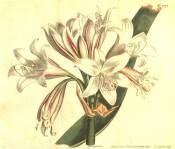Crinum lineare L.f.
Bulbous perennial with leaves to 60cm long, and flower stems to 30cm long, bearing umbels of up to 6, fragrant, funnel-shaped, white flowers, to 6cm long, tinged red in the centre. [RHSD, Baker Am., Verdoorn].
Horticultural & Botanical History
First botanically described as Crinum lineare by Linnaeus fils in 1782 [Suppl. Pl. p.195/1782].
It is figured under the name Amaryllis revoluta in Curtis’s Botanical Magazine [BM t.915/1806 and BM t.1178/1809]. The Botanical Register figures two varieties, robustior [BR f.615/1822] and gracilior [BR f.623/1822]. The former was ‘introduced from the Cape of Good Hope by Mr. Francis Masson in 1774, but still exceedingly rare in our collections.’ Paxton's Dictionary gives a date of introduction to Britain of 1823 for Crinum revolutum.
History at Camden Park
Crinum revolutum is listed in all catalogues [B.89/1843]. Earlier plants may have been lost as Macarthur included Crinum revolutum among desiderata to Loddiges’ nursery, 6th January 1845. [MP A2933-2, p.28]. Both Crinum koeganensis and Hippeastrum revolutum are listed in the 1843 catalogue only.
Crinum koeganensis was listed only in the 1843 catalogue and remained unidentified until the discovery of Bidwill’s notebook. He gave brief descriptions of 2 plants. The first of these two paragraphs was marked with a bracket down the left side and with the words ‘This plant is Crinum revolutum’. Bidwill offers no further explanation for the second plant. It seems likely that the offset he mentions was planted at Camden Park and was subsequently listed in the 1843 catalogue.
‘Crinum Koeganense. Leaves about 9 multifarious, sheathing 1½ to 2 feet long, 1½ inches wide edges approximating upwards to within ½ inch, sometimes largely [word undeciphered] near the base, greatly curved backwards, otherwise would be prostrate, not glaucous, margins quite entire, tube pear shape about 3 inches diameter, white, silky outside, not deciduous at Sydney. This bulb was given by Sir John Herschel to Lady Gipp at the Cape with the name Amaryllis Koeganense: but is evidently a Crinum. Although it has been nearly five years in Sydney and has never been disturbed it has not flowered and has made but one offset, which I have. May be C. Algoense – Page 272 [of Herbert’s Amaryllidaceae]. Oct 6th 1842. [It seems probable that Bidwill’s single offset was planted at Camden.]
Crinum Koeganense. Another plant in the same collection. Leaves glaucous but bright. 3 inches wide at the base largely undulated, young leaves not undulated ½ inch wide blunt, channelled, ciliated. A much larger plant than the other, not in the least like it. I had overlooked it through mistaking it for a Veltheimia amongst plants of which it was growing and which it resembled in the colour of its leaves. It is evidently different from either revolutum or variabile and from the leaves not being “tortuous” is not likely to be campanulatum.’ [Bidwill p.1].
Notes
Published Apr 27, 2009 - 05:18 PM | Last updated Jun 29, 2012 - 02:42 PM
| Family | Amaryllidaceae |
|---|---|
| Category | |
| Region of origin | South Africa |
| Synonyms |
|
| Common Name | |
| Name in the Camden Park Record |
Crinum revolutum, Crinum koeganensis, Hippeastrum revolutum |
| Confidence level | high |


